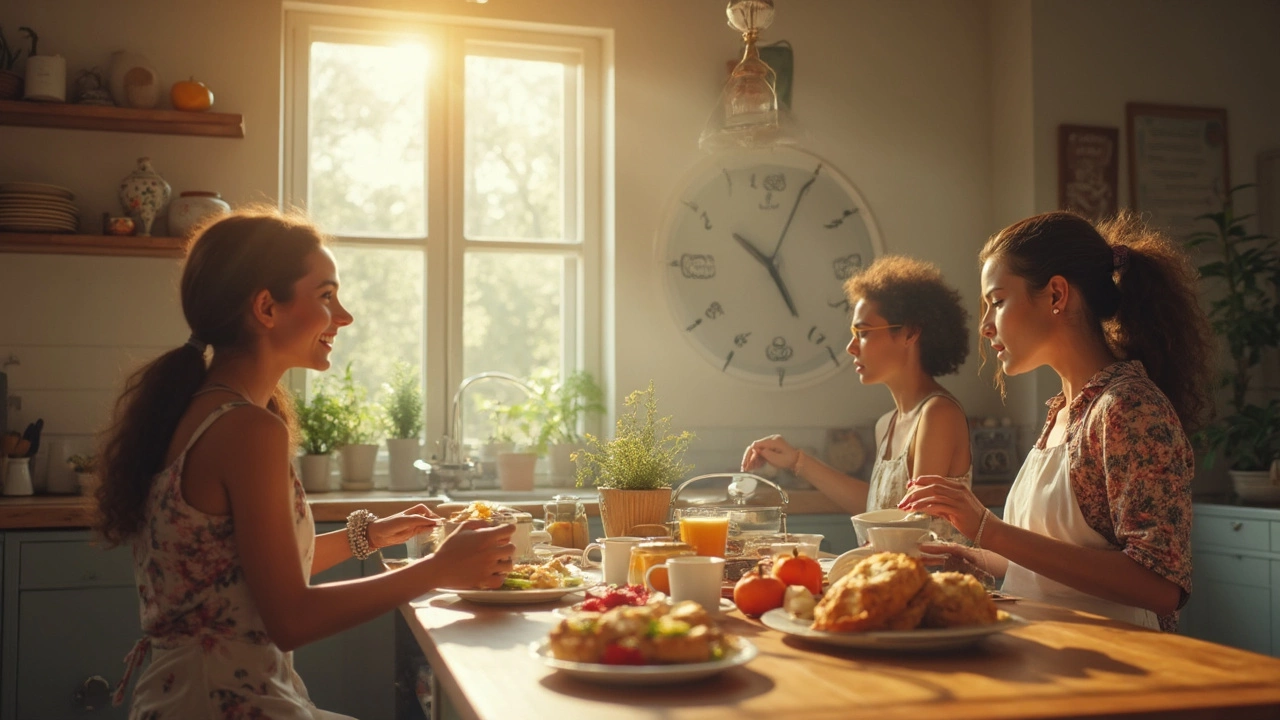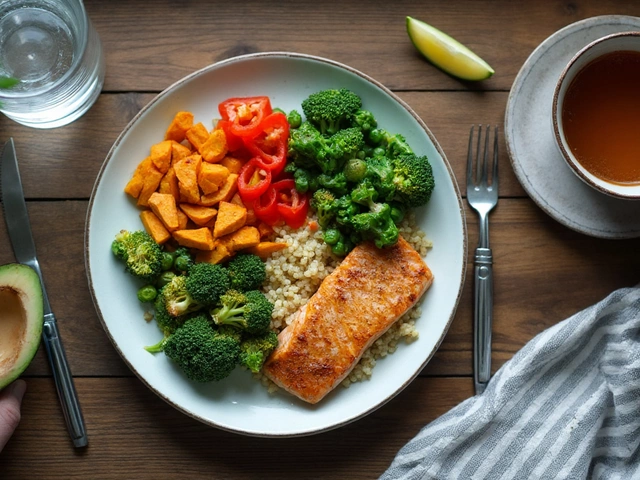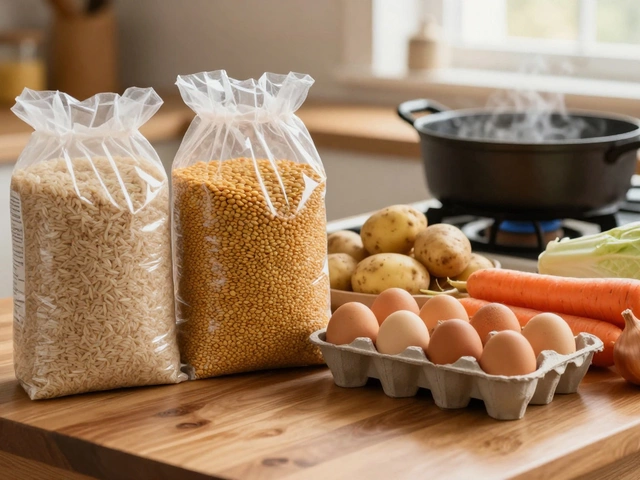
The 16 8 method is all about timing: eat all your meals within an 8-hour window, then take a break from food for the next 16 hours. Sounds hardcore? Not really. For most people, it means skipping breakfast or having a late one, eating lunch and dinner as usual, and then shutting the kitchen down after that. You’re basically eating during daylight and giving your body a break at night.
This works for a lot of people with crazy schedules or anyone who wants a simple rule around food without counting calories every day. One cool thing is, your lunch gets to be the star of your day, and that 8-hour window keeps you focused on meals you actually enjoy instead of endless snacking. With the 16 8 setup, quick lunches become even more important—think wraps you can build in three minutes, colorful bowls tossed together while answering texts, or leftovers that don’t require reheating.
- What is the 16 8 Method?
- Why This Method Fits Busy Schedules
- Easy Lunch Ideas for the 16 8 Window
- Tips for Sticking With It
- Common Questions and Honest Answers
What is the 16 8 Method?
The 16 8 method is a simple kind of intermittent fasting. It works like this: you eat during an 8-hour stretch, then you fast for the next 16 hours. That's it. No fancy formulas, weird meal replacements, or calorie tracking needed.
Most people pick noon to 8 p.m. as their eating window, but you can shift it to fit your job, family, or cravings. All the calories—from breakfast, lunch, snacks, whatever—fit into that 8-hour block. For the other 16 hours (which can include sleep), you stick to water, black coffee, or plain tea.
This method has gotten a lot of attention because it doesn’t tell you what to eat, just when to eat. According to a quote from Johns Hopkins neuroscientist Dr. Mark Mattson,
“Fasting for periods of time each day or eating just one meal a couple days a week may have benefits, like weight loss and a sharper mind.”
No system is magic, but studies have shown that folks following the 16 8 method tend to:
- Lose a bit of weight over time without feeling super restricted
- See more steady energy (say goodbye to the 3 p.m. slump)
- Find meal planning less stressful—fewer meals, fewer decisions
Here’s a quick comparison of typical daily schedules:
| Schedule | Eating Hours | Fasting Hours |
|---|---|---|
| Standard (8am-8pm) | 12 hours | 12 hours |
| 16 8 Method (12pm-8pm) | 8 hours | 16 hours |
The 16 8 method stands out because it asks for consistency, not perfection. You’re just drawing a line in your day—eat inside the window, hold off outside it. It’s flexible enough for students, working parents, or anyone who wants fewer food rules cluttering up their brain.
Why This Method Fits Busy Schedules
If you’ve ever felt too busy to fuss over complicated diets or meal prep, the 16 8 method is honestly made for you. It sets boundaries on eating: you decide your 8-hour window, eat when you can, and then forget about food till the next day. There’s no strict list of foods to buy, no hour-long cooking marathons—just a clear rule that saves tons of mental energy.
This fits well for folks who aren’t morning people or rush out the door without breakfast. You skip the most time-consuming meal and get more mileage out of simple lunches and dinners. A lot of people who work nine-to-five eat from 12 to 8 p.m., covering a quick lunch break and a regular dinner at home. You never have to explain a ‘weird’ diet to coworkers—lunch is still on the table.
Want some real-life proof? Studies from 2022 show that skipping just one meal means less time shopping, cooking, and cleaning—saving an average of 30–40 minutes every day. That’s nearly four hours a week you could use for, well, literally anything else.
| Schedule Type | Common 8-hour Window | Saved Time per Week |
|---|---|---|
| Office/9-to-5 | 12 p.m. - 8 p.m. | 4 hours |
| Night Shift | 5 p.m. - 1 a.m. | 3.5 hours |
| Stay-At-Home Parent | 10 a.m. - 6 p.m. | 4 hours |
It’s flexible. You can pick an eating window that fits with your life, your energy, and when you actually want a meal. If a doctor’s appointment or a last-minute meeting pops up, you can shift your window a little. No need to whip out a calorie tracker on your phone in public. The 16 8 method is low-maintenance, and that’s gold for busy people.

Easy Lunch Ideas for the 16 8 Window
When you’re following the 16 8 method, lunch comes with bonus energy because you’ve waited for it. You want stuff that’s satisfying, quick, and gives you steady power through your eating window. The best quick lunches have three things in common: they’re easy to prep, fill you up, and hit the right mix of protein, healthy fats, and fiber.
- Wraps and Sandwiches: Grab a whole grain wrap, pile on some rotisserie chicken, leafy greens, and a swipe of hummus. Takes two minutes—harder to pronounce quinoa than make this one.
- Salad Bowls: Start with a base like spinach or arugula, add chickpeas (straight from the can), cherry tomatoes, grated carrots, and a hard-boiled egg. Toss in some olive oil and lemon juice. You don’t need a chef’s hat to throw it together.
- Rice or Grain Bowls: Use microwavable brown rice, leftover steak or tofu, roasted veggies, and a dollop of Greek yogurt. It’s all about leftovers and layering flavors fast.
- Protein Boxes: Channel your inner barista—make your own protein box with boiled eggs, string cheese, grapes or berries, and a handful of nuts. Great for on-the-go workers or parents juggling emails and errands.
- Leftover Makeovers: Had roasted veggies or baked salmon for dinner? Layer those in a container with greens or grains and call it lunch. You save time and cut food waste.
Here’s a look at how simple meal building can keep your energy steady during the intermittent fasting window:
| Lunch Combo | Prep Time | Main Benefits |
|---|---|---|
| Chicken Wrap + Veggies | 5 min | Protein, fast to make |
| Chickpea Salad Bowl | 7 min | Fiber, plant protein |
| Rice & Leftover Steak | 8 min | Sustained energy |
| Protein Snack Box | 3 min | Portable, no mess |
If you want these lunches to really work during your 16 8 method schedule, prep key ingredients at the start of the week—think boiled eggs, pre-chopped veggies, and cooked grains. That way, you just toss or wrap stuff together when hunger hits. Also, keep grab-and-go proteins, like Greek yogurt or cottage cheese, stocked in your fridge. Phoebe and I do this every Sunday. Makes life easier and the meals pretty much make themselves. The real trick? Keep lunch simple and don’t overthink it. You want to fuel up, not stress out.
Tips for Sticking With It
You start off super motivated with the 16 8 method, but the real trick is making it a habit that you can actually keep up. Here’s what actually helps when life gets in the way.
- Ease into it. You don’t have to jump straight to a full 16-hour fast. Try a 12-hour gap first—say, stop eating at 8 pm, have breakfast at 8 am—then stretch your window out by an hour or so each week. Your body will adjust way better.
- Set your eating window around your lifestyle. If lunch with coworkers is non-negotiable, build your window so you’re not the odd one out. If you always eat dinner with family, start your window later. Flexibility is huge for making intermittent fasting stick.
- Plan your quick lunches. Prepping lunch the night before, or even just jotting down what you’ll eat, stops you from scrambling and accidentally breaking your fast early. Easy go-tos: chicken wraps, grain bowls with whatever’s in the fridge, or Greek yogurt with fruit if you’re in a rush.
- Drink plenty of water. Sometimes you think you’re hungry, but you’re actually just thirsty. Sparkling water or black coffee are fair game during fasting—just skip the sugar and milk.
- Keep temptation out of sight. I keep the snack cupboard out of reach during fasting hours (and honestly, so does Phoebe). If it’s not staring you down, it’s easier to not break your healthy habits.
For folks who love data, tracking apps can help keep you honest. Some apps ping you when it’s time to start or stop eating, and they’ll show your fasting streaks. That little dopamine hit can be weirdly motivating.
| Tip | Why It Works |
|---|---|
| Start slow | Your body gets time to adapt, less chance of giving up |
| Prep lunches | No stress, no unexpected snacks |
| Stay hydrated | Fights off hunger and keeps energy up |
| Get support | Spouse or buddy doing it with you = accountability |
If you ever slip up, just get back to it the next day. Most people who make the 16 8 method part of their lives focus on progress, not perfection. Build the window that works for you, and roll with it.

Common Questions and Honest Answers
People like to ask a lot about the 16 8 method—so here's what you need to know, no fluff.
Do I have to skip breakfast?
Nope. You choose your 8-hour window. Some folks go from 10 a.m. to 6 p.m. so they can eat breakfast and finish early. Others start at noon and wrap up by 8 p.m. Choose whatever feels most natural with your routine—nobody's saying you can never eat eggs before lunch again.
Can I drink anything during the fasting time?
Yep, but keep it simple. Water, black coffee, and unsweetened tea are all good. Skip sugar, milk, and anything with calories until your window opens up again. Most people find that coffee or herbal tea helps fight off hunger in the morning, too.
Will I lose weight?
Most folks who stick to intermittent fasting, like the 16 8 method, do see some pounds drop. It's not magic—it just helps you eat less by squeezing your meals together. There's a study in 2020 (JAMA Network) where adults lost about 3% of their body weight after 12 weeks on a similar fasting plan without changing what they ate. But honestly, weight loss isn't guaranteed for everyone.
| Study | Duration | Avg. Weight Loss |
|---|---|---|
| JAMA Network 2020 | 12 weeks | 3% body weight |
What if I get really hungry?
The first week can be tough—your body loves habits and doesn't want to change. Try to stick it out for a few days. Keep busy, sip on water or tea, and if you slip up, just get back to it the next day. No guilt trips needed. And make sure your main meals are filling: protein, fiber, and healthy fats go a long way in keeping you full.
Does this work if I work out?
Absolutely. If you train hard, just line up your workout so you can eat right after. That way, your body’s getting fuel soon after exercise, which matters for muscle and recovery. Plenty of folks hit the gym before their first meal and do fine. Just listen to your body—if you’re dragging, try moving the eating window earlier.
Can I do the 16 8 method every day?
Most people do, but you don't have to. If you want the weekends off, go for it. Or if a special occasion comes up (like my wife Phoebe busting out homemade cinnamon rolls at sunrise), don’t sweat it. Flexibility keeps you sane long term.
Anything else? If you've got medical challenges—diabetes, pregnancy, or anything tricky—chat with your doctor first. For most healthy adults, the 16 8 method is simple, cheap, and easy to try. Just keep the focus on what works for you, not what works for your neighbor.





